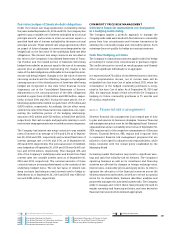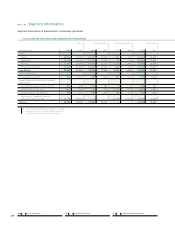Siemens 2014 Annual Report Download - page 301
Download and view the complete annual report
Please find page 301 of the 2014 Siemens annual report below. You can navigate through the pages in the report by either clicking on the pages listed below, or by using the keyword search tool below to find specific information within the annual report.
247 D. Consolidated Financial Statements 337 E. Additional Information
248 D. Consolidated Statements of Income
249 D. Consolidated Statements of Comprehensive Income
250 D. Consolidated Statements of Financial Position
251 D. Consolidated Statements of Cash Flows
252 D. Consolidated Statements of Changes in Equity
254 D. Notes to Consolidated Financial Statements
330 D. Supervisory Board and Managing Board
Fair value hedges of fixed-rate debt obligations
Under the interest rate swap agreements outstanding during
the years ended September , and , the Company has
agreed to pay a variable rate of interest multiplied by a notional
principle amount, and receives in return an amount equal to a
specified fixed rate of interest multiplied by the same notional
principal amount. These interest rate swap agreements offset
an impact of future changes in interest rates designated as the
hedged risk on the fair value of the underlying fixed-rate debt
obligations. The interest rate swap contracts are recorded at
fair value in the Company’s Consolidated Statements of Finan-
cial Position and the related portion of fixed-rate debt being
hedged is recorded at an amount equal to the sum of its carrying
amount plus an adjustment representing the change in fair
value of the debt obligations attributable to the respective inter-
est rate risk being hedged. Changes in the fair value of interest
rate swap contracts and the offsetting changes in the adjusted
carrying amount of the related portion of fixed-rate debt being
hedged are recognized in line item Other financial income
( expenses), net in the Consolidated Statements of Income.
Adjustments in the carrying amount of the debt obligations
resulted in a gain (loss) of €() million and € million, respec-
tively, in fiscal and . During the same period, the re-
lated swap agreements resulted in a gain (loss) of € million and
€() million, respectively. Accordingly, the net effect recog-
nized in line item Other financial income (expenses), net, repre-
senting the ineffective portion of the hedging relationship,
amounts to €() million and €() million, in fiscal and ,
respectively. Net cash receipts and payments relating to such
interest rate swap agreements are recorded as interest expenses.
The Company had interest rate swap contracts to pay variable
rates of interest of an average of . % and . % as of Septem-
ber , and , respectively and received fixed rates of
interest (average rate of . % and . %, as of September ,
and , respectively). The notional amount of indebted-
ness hedged as of September , and was € , mil-
lion and € , million, respectively. This changed % and
% of the Company’s underlying notes and bonds from fixed
interest rates into variable interest rates as of September ,
and , respectively. The notional amounts of these
contracts mature at varying dates based on the maturity of the
underlying hedged items. The net fair value of interest rate
swap contracts (excluding accrued interest) used to hedge in-
debtedness as of September , and was € mil-
lion and € million, respectively.
COMMODITY PRICE RISK MANAGEMENT
Derivative financial instruments not designated
in a hedging relationship
The Company applies a portfolio approach to manage the
Company-wide risks associated with fluctuations in commodity
prices from firm commitments and forecast transactions by
entering into commodity swaps and commodity options. Such
a strategy does not qualify for hedge accounting treatment.
Cash flow hedging activities
The Company’s corporate procurement applies cash flow hedge
accounting for certain firm commitments to purchase copper.
The ineffective portion as well as resulting gains and (losses)
were not significant individually or in aggregate.
It is expected that € million of net deferred losses in line item
Other comprehensive income, net of income taxes will be
reclassified into line item Cost of sales in fiscal , when the
consumption of the hedged commodity purchases is recog-
nized in line item Cost of sales. As of September , and
, the maximum length of time over which the Company is
hedging its future commodity purchases is months and
months, respectively.
NOTE Financial risk management
Siemens’ financial risk management is an integral part of how
to plan and execute its business strategies. Siemens’ financial
risk management policy is set by the Managing Board. Siemens’
organizational and accountability structure as of September ,
requires each of the respective managements of Siemens
Sectors, Financial Services, SRE, regions and Corporate Units
to implement financial risk management programs that are
tailored to their specific industries and responsibilities, while
being consistent with the overall policy established by the
Managing Board.
Increasing market fluctuations may result in significant earn-
ings and cash flow volatility risk for Siemens. The Company’s
operating business as well as its investment and financing
activities are affected by changes in foreign exchange rates,
interest rates, commodity prices and equity prices. In order to
optimize the allocation of the financial resources across the
Siemens segments and entities, as well as to secure an optimal
return for its shareholders, Siemens identifies, analyzes and
proactively manages the associated market risks. The Company
seeks to manage and control these risks primarily through its
regular operating and financing activities, and uses derivative
financial instruments when deemed appropriate.
























